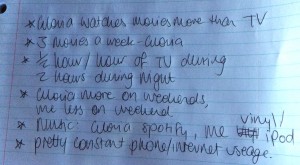Basically, our second last assignment in Popular Culture is a group project that needed to be presented in weeks 10 and 11. One thing that my group mates and I share is… that we’re all girls. So we had this super broad topic that we needed to research on, which was ‘music videos’ and thought that we could all make points on feminism in music videos including its history from the 80s, controversies, girl groups, individual female artists and dancing aspects. Like all other procrastinators out there, we started meeting up and had skype sessions weeks after we were introduced of the assignment and tend to practice the speech on the 7:40 AM before the pressie time. Even got a little bit confused whether or not we are presenting in week 10 or 11 to be honest. Yet, it turned out that we did pretty good covering our topic of how feminist artists came to be, what’s really behind Miley Cyrus’ expression in her “Wrecking Ball”, the obviously controversed “Blurred Lines” and etc. After all it was hell fun working with these girls, seeing that we would just have ONE more assignment to be done for the end of the semester!
Author: Gloria T
Rachel’s tips
On 1st Draft
So we have quite a rough idea on what do to our media artefact on, which is an audio documentary. Bianca and Patrick have been finding sample soundtracks to put in the piece. As we progresses through our research with what was considered from Rachel, we had another talk in our weeks 10 and 11:
- Ranging information from the past, present, and the future of sound history (Paradigm shift).
- Research more on the future predictions.
- Add more variety in sounds that will be included in the piece to give texture (with each of us; Bianca, Patrick and I have a go on recording our own voice).
- Look forward into interviews with experts.
A Step Up to Brief 4
Another one started just as soon as Brief 3 finished. As a group project, it’s required that we produce a media artifact regarding a conceptual idea, ‘Technology’. Therefore, Bianca, Patrick and I have been exchanging Facebook, setting up our G-Docs, and dropping down brainstorming ideas about what might be of our interest for how we are going to produce the artifact. By week 8, we have done a collaborative contract and had a start on an annotated bibliography that was due in week 9.
From this “brainstorm poster”, we decided to make an audio podcast-like documentary consisting the history sounds that have evolved alongside technology. Sounds that undergo paradigm shifts, assisted by Rachel while pointing out about a timeline of the past, presence and future of sound productions and consumptions. Hence, in heading to this direction we divided parts in researching the history in a more in-depth investigation to support the script for our audio piece.
This are some of the task that I’ve started:
- Do a research about audio technology from MP3 player to streaming period (1990s-present)
- Find further information regarding the future possibilities.
- Write a script consisting the research information.
- Plan for recording meeting.
The Grizzly Man’s Road
Reading Log #9
It’s all about the director… mostly.
Like fictional films, documentaries have different forms and genres. The nature docudrama film, Grizzly Man (2005) by a German director and narrator Werner Herzog is a portrait. It is about a bear enthusiast, Timothy Treadwell who camped in a remote Alaskan land of Grizzly bears for thirteen summers before he died. Including Treadwell’s recordings of his bear interactions as archival sources makes the documentary a compilation film. The dramatic yet artistic sense is assisted by the Treadwell’s own footages he took of himself and his encounters with the bears, where he narrates his expedition. “It has been only five days since the baby (bear) died, … it’s so sad, it was so cute.” Treadwell had spoken out with informative yet dramatic and casual tone. Furthermore, chain of interviews of close friends, work mates, nature experts and relatives are selected and inserted to vary the genres in order to engage with the audience with an appeal of ranging techniques.
Narrated by Herzog, he is able to ask rhetorical questions and presents a persuasive, viewer-centered argument, making his film a rhetorical form and an opinionative issue. “… Could this one be bear 141 (Treadwell’s murderer)? What looks playful could be desperation.” To Timothy Treadwell, bears are his friends and believe in the gradual friendliness of the bears to him but Herzog doubted the bears and positions the audience to either side of the argument using the enthymeme. It is a rhetorical form also because it provokes an emotional appeal, even though the conclusion cannot be proved beyond question.
https://www.youtube.com/watch?v=EjwLkKih1hQ
Remixes & Reproductions
Dan explains today that “There’s no such thing as an original idea”. Week 11 lectorial proposes an interesting topic on reproductions and how DJs come about from the histories of discotheque and night clubs. During the 1920s the people would dance to music on a piano or Jukebox. Where in the late 1970s, DJs would have been needed to provide music with seamless transition between songs. Even then, the birth of the Internet has allowed these artists to perform their art, downloading song whether or not there is still a matter based on copyright infringement. The question is how authentic is the reproduction and how much of the aura is captured? Because we can never capture a moment exactly as it is in reality which is different from the digital world. We can try but always have been fragments in our memory.
“This Is The Remix”
Girl Talk
Andy Warhol’s Campbell’s Soup Cans
“Pop art does not describe a style; it is much rather a collective term for artistic phenomena in which the sense of being in a particular era found its concrete expressions…”
(Osterwold, pop art, p.6)
Institutions
What are institutions?
Our week 10 Lecture describes this as a term from sociology concerning with organising the structures of a society. In relation to its social, cultural, political and economic factors, there are principles, values and rules that underly these structures. We see a community or an organisation structured to govern the behaviour of a set of individuals like universities, hospitals and even marriages. When watching a film, say Fast and Furious, its narrative is comprised with institutions such as the drivers, gangs and polices. These are examples of institutions and we as students are part of an establishment.
Media Institutions
Broadcast television . Community Radio . Journalism . Cinema . The News . Newscorp . ABC . Public Service Broadcasting
Media institutions, like any other institutions are enduring. The cinema industry would have regulations and structured activities, while developing working practices to produce its films. Furthermore, institutions are a collectivist, reaching to own’s particular goal as the community share expected values. Finally, the public is aware of its status as how google is widely recognised of its status.
Marriage as Social Institution
Marriage is not just based on love and relationship but a social structure involving a set of usually two individuals with expectations. As a widely accepted cultural rules and practice, it is legal and a community recognition that can be known as a legal framework. Often we associate marriage with religion because of its superstitions and rituals that are symbolic of religious practices. Containing moral values, these expectations may involve to be faithful in which the relationship is monogamy. When two are married, the public is aware of its status from the rings they wear. They share certain values as they develop the relationship and working on a particular goal in life through a utilised set of regulations/ compromises discussed between the two. These conventions conveyed in a marriage makes this practice a social institution.
The Style of Scorsese
Reading Log #8
I have seen The Wolf of Wall St (2014), The Age of Innocence (1993), Shutter Island (2010) and all those directed by Martin Scorsese has particular style that became the director’s signature in making film. The director often engages with gangster films, with social violence while interested with both European art cinema and Hollywood classical narrative. He is influenced, or inspired by early cinema with long takes and montage such as of Eisenstein and Hitchcock. Elliptical editing is specially a motif in which Scorsese has ritually complemented in The Age of Innocence and other films to reduce time and space.
Different filmmakers have their own individual approach in portraying their character’s mental subjectivity. In The Age of Innocence for example, the character Newland Archer (starring Daniel Day Lewis) desires to be with Ellen Olenski despite already having an engagement with May Welland. Scorsese has shown this perspective from Newland’s point of view shots following Ellen around the room and tracking away from May to dislocate her outside the frame. Montage and jump cuts are often used and became a pattern to portray hallucinations or imaginations of the characters. Similar techniques are also used in The Wolf of Wall St when the main character is under a drug, causing his instability of vision. Both movies promotes the ideologies of the rich families of New York’s high society and this portrayal itself is a motif occurring in many of Scorsese’s films.
Audiences
Audience is the primary topic of our week 9 lectorial. Wide range of community including advertisers, commercial broadcasters, individual program makers, government policy makers, psychologists, cultural theorists all care about their audience. One of the characteristics of a post-broadcast era is that there is a change in audience practices, making TV for instance, as cultural technology. I’ve thought about myself watching the New Girl show during holidays instead of actually “going out”, or my mum being glued to the telly watching episodes of CSI and Doctor Who all day and even my friends on Spotify. Many of us as audiences are affected by the digitalisation and as mass culture and audience progresses, the idea evaluates that real life is becoming indistinguishable from the movies.
I’ve also remembered my little brother undergoing the process of interpellation after watching Avengers and acting like that Captain America hero. Interpellation is, in other words when an individual is prompted by a text to recognise themselves as being a subject belonging to a role. Not one of us has not been there let’s be honest. Furthermore, binge watching (or some other kinds of reading). Been there, done that… like these two here.
Moreover, audiences have specific tastes or desires and makers may think of them as the public, social glue or an imagined community. So we did a little activity talking about our uses of texts and this is what Bianca and I came up with:
Listen to me!
https://www.youtube.com/watch?v=-Rgvyz7Yq1Y
In reading media texts, we need to listen to the sounds being produced. I found this video from You Tube by thebigtinonetwork about a little boy learning and behaving as his parents from observation and listening. Like what the kid is saying… Listen!
Sound is…
- Pervasive
- Multi-directional
- Complexly layered
- Prioritised by the ear
- Intimate
As aural semiotics, it place the listener in a mediated or imagined perspective. These perspectives include figure, ground and the field. There is a difference between perspective and the system of social distance. Where social distance applies to single sounds, perspective applies to the simultaneous sounds and has relatives rather than absolute levels. Moreover, social distance creates relations of different degrees of formality between the representation and the listener.
Figure: The focus of interest
Ground: The setting or context
Field: The background or ambient space, what is heard
Soundscape
Soundscape refers to representations of a place or an environment that can be heard, rather than be seen. It is understood by individuals in different ways. Some of us can listen to music and actually understand its sounds and notes. But some does not. Some are more sensitive with particular sounds like the air whooshing when others just listen to its silence. Silence itself doesn’t exist and when I think about it, I hear every time even of the fridge whirring when nothing else seems to sound.
Man Of No Ego – Slowing Down (Web of Life)
https://www.youtube.com/watch?t=204&v=TwuF2mJA3Gw
How sound is complemented
Reading Log #7
Sound in the cinema is a crucial component to cinematic narration processes. They give cues in both onscreen and off-screen as audiences synchronize what is shown to the sound produced. Cues given by sounds allow audiences to anticipate and understand the intended reading of the narrative, besides according to their experiences.
As exemplified in Vivre Sa Vie, 1962 by Jean-Luc Godard, the voices of the characters are often off-screen while the character itself is not present on the screen. This use of dialogue gives cues in which the audience understands that the character on screen, who is not speaking nor moving any lips movements, is communicating with the character that is off-screen because of the use of the character’s voices.
The presence of background noises like those in the café scene is the diegetic effect as we hear the plates and cups clanking. But as there is a dialogue between the characters, this low-pitch and average-volume dialogue sound is dominant and guided our attention (or to listen) to itself whilst the low-volume noises are secondary mixing of sounds. This is followed by a background music coming in. This French musical soundtrack is the non-diegetic effect that adds timbre and harmony to the scene. As the character speaks, there are moments of silence and this is a motif shown throughout the film. The purpose of this silence is to guide the audience focus and attention on the scene/shot presented.









